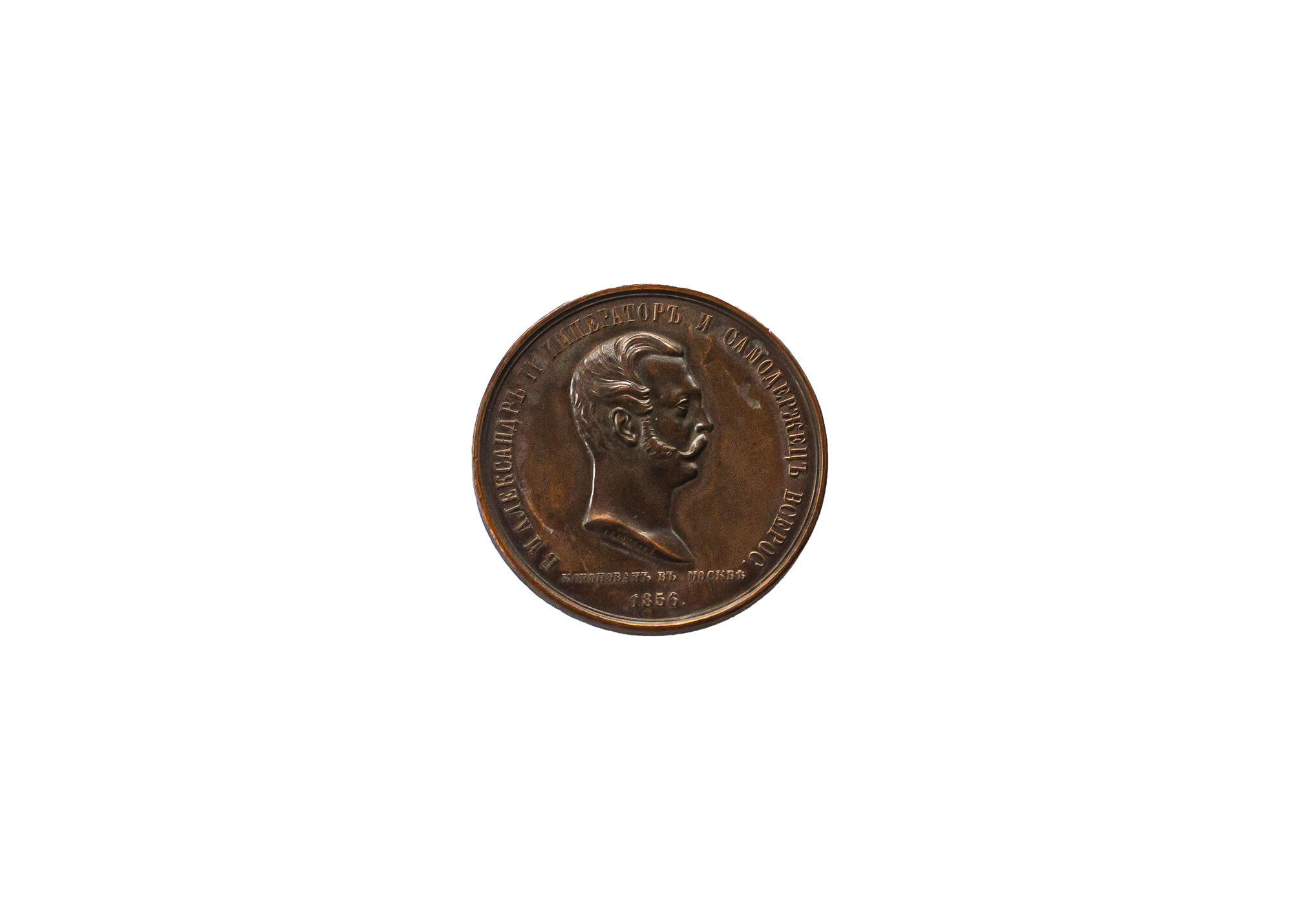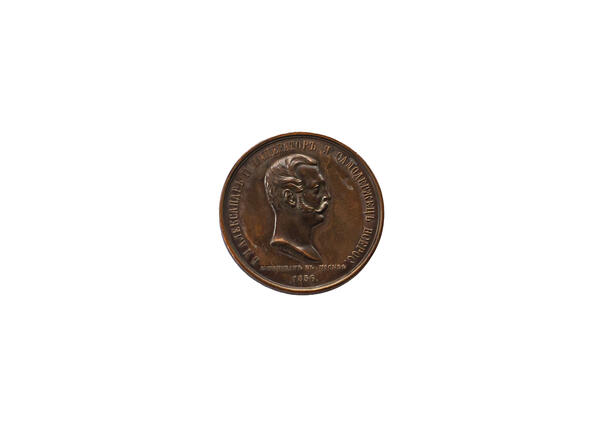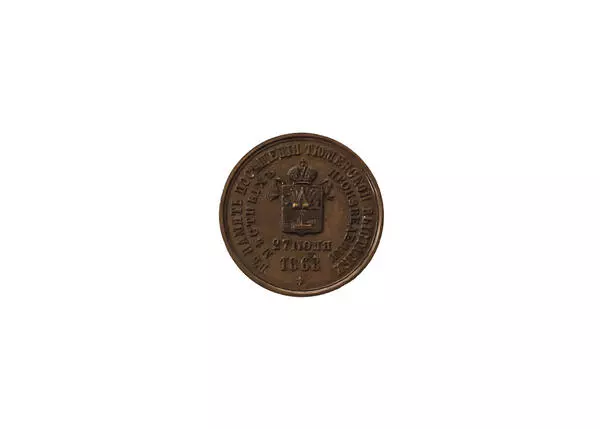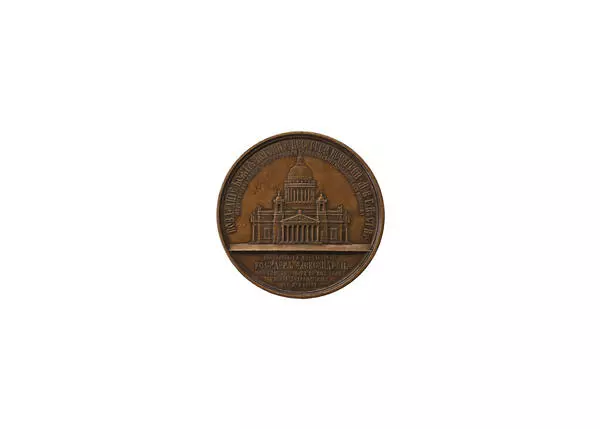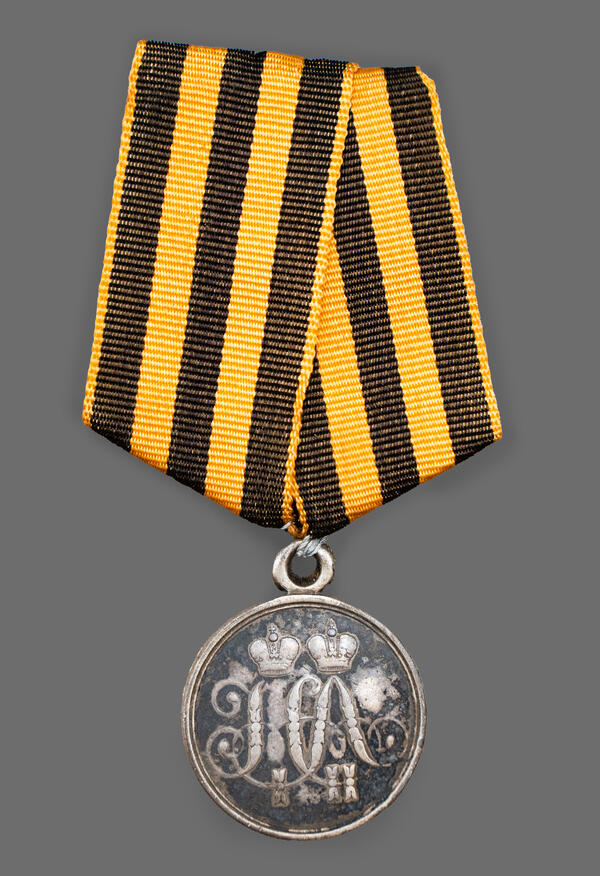The commemorative medal, display in the exhibition, was made in honor of the coronation of Alexander II.
On the obverse of the medal, there is a chest-length portrait of the Emperor in profile. The inscription is carved on the circle: “B. M. Alexander II Emperor and Autocrat of All Russia.” At the bottom, there is a phrase in two lines: “Crowned in Moscow // 1856.” On the portrait of the emperor, at the very bottom of the neck, you can see the signature of the portrait medallist Vasily Alexeyev.
On the reverse of the medal, there is the coat of arms of the Russian Empire: the double-headed eagle with the wings spread, crowned with three imperial crowns. He holds a scepter and an orb. The breast of the eagle bears the coat of arms of Moscow and the chain of the Order of Saint Andrew the First-Called, while the wings bear the coat of arms of the kingdoms of Kazan, Poland, Tauris, Kyiv, Astrakhan, Siberia, Georgia, and Finland. Above the eagle, there is an inscription: “God is with us.” At the bottom, along the edge, there is the signature of the second craftsman who worked on the medal, Robert Ganneman.
Alexander II ascended the Russian throne after the death of his father, Nicholas I, on February 18, 1855. But it was decided to postpone the ceremony because of the Crimean War. The coronation of the Emperor took place only one and a half years later, already after the signing of the Paris Peace Treaty. Alexander II arrived in Moscow on August 14, 1856, by the Nikolaevskaya railroad and stayed at the Petrovsky Palace. His ceremonial entry into the capital took place on August 17. The tsar rode on horseback, accompanied by grand dukes, foreign princes, numerous retinue, and escorts.
The procession stopped at the Iverskiye Gate and then continued through Red Square to the Spasskiye Gate. These gates were considered holy — an icon was usually placed above them. Since the cross processions passed through them, all men had to remove their hats before entering, thus showing their respect for the holy places. The custom was looked over by the guards. Alexander II entered the Spasskiye Gate with his head uncovered, according to the tradition.
The ceremony was scheduled for August 26. It was announced by heralds in the town squares three days before the ceremony itself. The coronation took place in four traditional stages: a solemn procession to the Assumption Cathedral, laying ceremony of the imperial crown and royal regalia, the sacrament of anointing, a procession to the Cathedral of the Archangel, and the Cathedral of the Annunciation to visit the graves of their ancestors, and a return to the palace with the obligatory threefold bowing to the people from the Red Porch. The feast continued with a dinner in the Faceted Chamber.
On the obverse of the medal, there is a chest-length portrait of the Emperor in profile. The inscription is carved on the circle: “B. M. Alexander II Emperor and Autocrat of All Russia.” At the bottom, there is a phrase in two lines: “Crowned in Moscow // 1856.” On the portrait of the emperor, at the very bottom of the neck, you can see the signature of the portrait medallist Vasily Alexeyev.
On the reverse of the medal, there is the coat of arms of the Russian Empire: the double-headed eagle with the wings spread, crowned with three imperial crowns. He holds a scepter and an orb. The breast of the eagle bears the coat of arms of Moscow and the chain of the Order of Saint Andrew the First-Called, while the wings bear the coat of arms of the kingdoms of Kazan, Poland, Tauris, Kyiv, Astrakhan, Siberia, Georgia, and Finland. Above the eagle, there is an inscription: “God is with us.” At the bottom, along the edge, there is the signature of the second craftsman who worked on the medal, Robert Ganneman.
Alexander II ascended the Russian throne after the death of his father, Nicholas I, on February 18, 1855. But it was decided to postpone the ceremony because of the Crimean War. The coronation of the Emperor took place only one and a half years later, already after the signing of the Paris Peace Treaty. Alexander II arrived in Moscow on August 14, 1856, by the Nikolaevskaya railroad and stayed at the Petrovsky Palace. His ceremonial entry into the capital took place on August 17. The tsar rode on horseback, accompanied by grand dukes, foreign princes, numerous retinue, and escorts.
The procession stopped at the Iverskiye Gate and then continued through Red Square to the Spasskiye Gate. These gates were considered holy — an icon was usually placed above them. Since the cross processions passed through them, all men had to remove their hats before entering, thus showing their respect for the holy places. The custom was looked over by the guards. Alexander II entered the Spasskiye Gate with his head uncovered, according to the tradition.
The ceremony was scheduled for August 26. It was announced by heralds in the town squares three days before the ceremony itself. The coronation took place in four traditional stages: a solemn procession to the Assumption Cathedral, laying ceremony of the imperial crown and royal regalia, the sacrament of anointing, a procession to the Cathedral of the Archangel, and the Cathedral of the Annunciation to visit the graves of their ancestors, and a return to the palace with the obligatory threefold bowing to the people from the Red Porch. The feast continued with a dinner in the Faceted Chamber.
